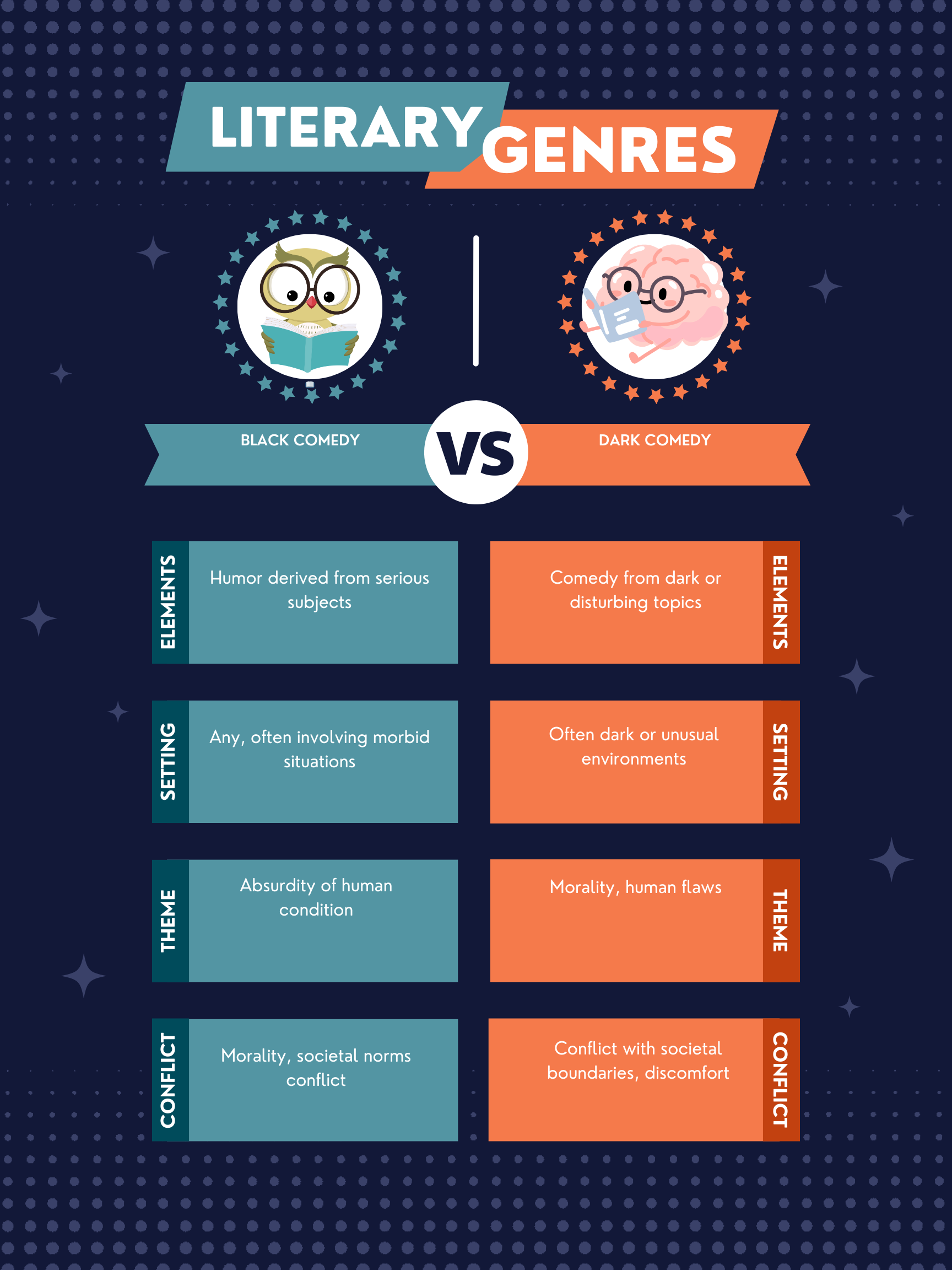Both terms often used interchangeably, referring to comedy that deals with disturbing or taboo topics in a humorous way; nuances in usage can vary, but generally, they both involve humor derived from darker aspects of life.
In the realm of storytelling, black comedy and dark comedy light up the darker corners of human experience with humor. Let’s take a closer look at these compelling literary devices. 😈🤣
Black Comedy
Black comedy, or black humor, delves into topics that are generally considered serious, taboo, or disturbing, using humor to explore the absurdity or irony inherent in them. “Catch-22” by Joseph Heller is an iconic example, satirizing the absurdities of war and bureaucracy.
Dark Comedy
Dark comedy shares much with black comedy, often focusing on similarly grim subjects but can sometimes imply a slightly different tone or approach, perhaps with a more explicit emphasis on the humor aspect in the face of dark themes. “Fargo,” by the Coen Brothers, with its blend of crime, violence, and quirky, humorous situations, serves as a fitting example.
Summary
| Literary Device | Definition | Purpose | Usage | Relevant Examples |
|---|---|---|---|---|
| Black Comedy | Comedy that derives humor from disturbing or taboo topics. | To provoke thought and laughter by presenting dark themes humorously. | Literature, film, theater. | “Catch-22” by Joseph Heller. |
| Dark Comedy | Similar to black comedy, focusing on grim subjects with an emphasis on humor. | To entertain and illuminate the absurdity of dark situations through humor. | Literature, film, theater. | “Fargo” by the Coen Brothers. |
Writing Tips
For Black Comedy:
- Balance Tone: Find the right balance between the gravity of your themes and the humor you use to explore them.
- Explore the Absurd: Use absurd situations or exaggerations to highlight the ridiculousness inherent in dark topics.
- Respect Your Audience: Be mindful of how your audience might react to humor about sensitive subjects.
For Dark Comedy:
- Emphasize Humor: While exploring dark themes, ensure the humor shines through to keep the audience engaged.
- Character Reactions: Characters’ reactions to dark situations can be a source of humor, highlighting their resilience or naiveté.
- Creative Situations: Invent unique, bizarre situations that naturally blend dark themes with comedic elements.
FAQs
Are black comedy and dark comedy the same?
While they are often used interchangeably and share many characteristics, nuances in tone, theme, and emphasis can vary between the two.
Can a story be both a black comedy and a dark comedy?
Yes, many stories blend the characteristics of both, using humor to explore dark or taboo subjects.
Exercise
Read the following excerpt: “As the hearse broke down on the way to the funeral, the family decided to carry the coffin the rest of the way, turning heads at every corner.”
Answer: This passage exemplifies elements of black comedy, presenting a grim situation—the transportation of a coffin—with an absurd, humorous twist.
Other Interesting Literary Device Comparisons
- Irony vs Satire: Irony involves saying the opposite of what is meant, often subtly, while satire uses humor or exaggeration to criticize.
- Parody vs Satire: Parody imitates a work or style for comedic effect, while satire critiques social or political issues.
- Sarcasm vs Verbal Irony: Sarcasm is a form of verbal irony that is often biting or harsh, intended to mock or convey contempt.
Exploring the boundaries and overlaps between black comedy and dark comedy reveals the rich potential for humor to illuminate, critique, and entertain within the darker aspects of life. 🌑😄

